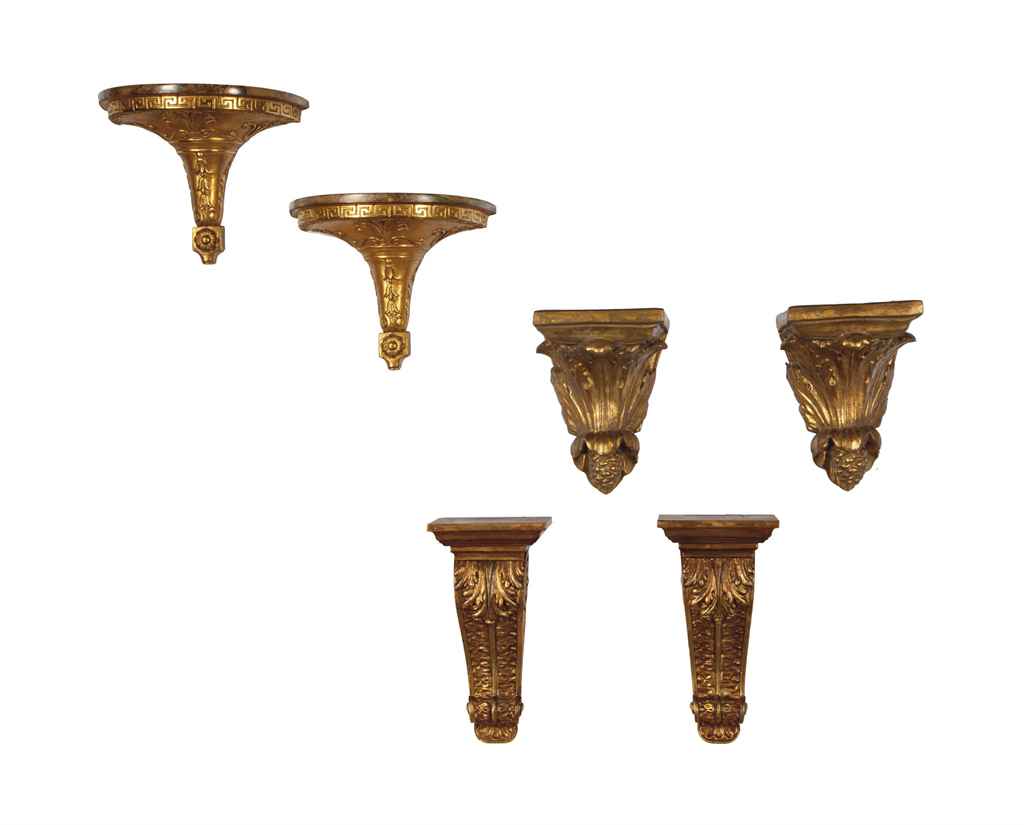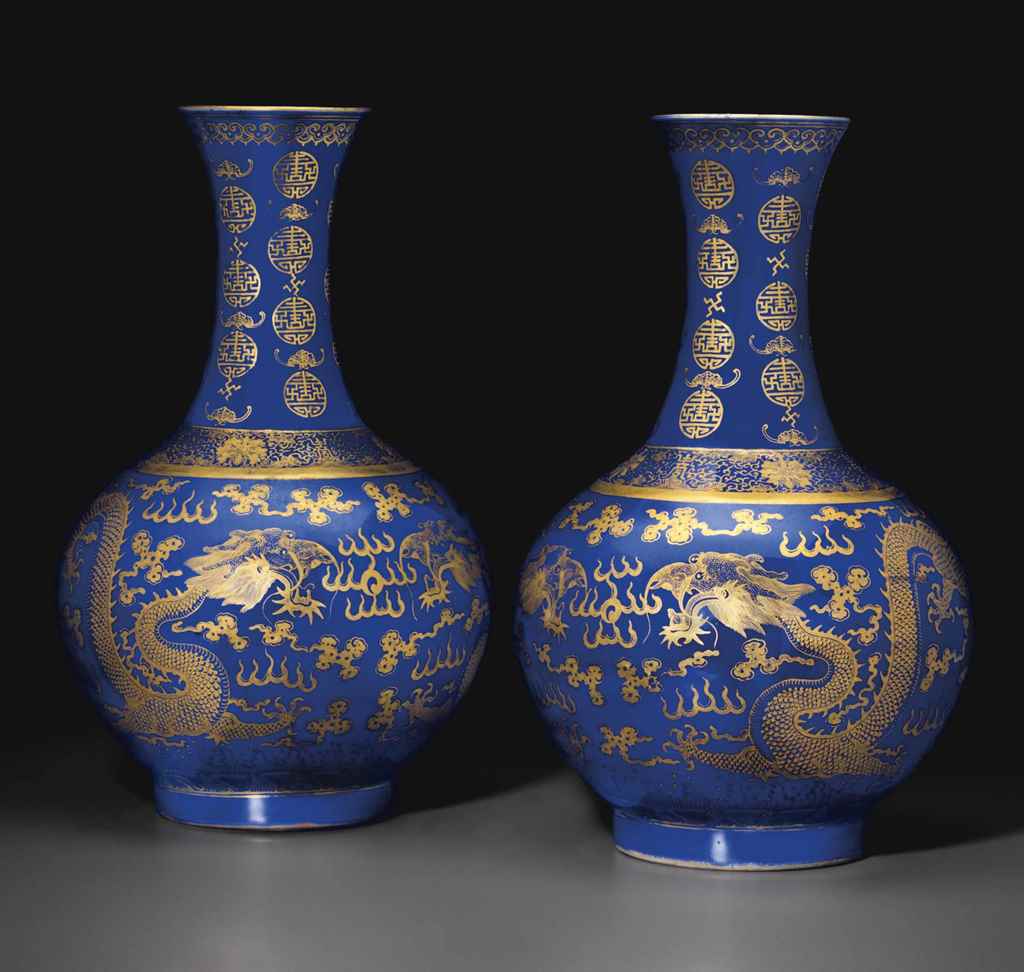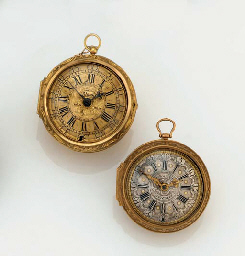A PAIR OF GILT BRONZE COPIES OF THE WARWICK URN, 19th Century, on green marble pedestal bases, 21cms wide, 15cms high The Warwick vase, an ancient Roman marble vessel with Bacchic ornament was discovered at Hadrians Villa, Tivoli about 1771 by Gavin Hamilton a Scottish painter-antiquarian, and more importantly and an art dealer in Rome. Hamilton had been given permission to carry out excavations and so proceeded to drain the marshy area around the villa. He sold the fragments to William Hamilton British envoy at the court of Naples. While the design and ornamentation date to the Hellenistic period of 2nd Century Rome, the extent to which the fragments were restored and further completed after its discovery is significant. As Sir William Hamilton remarked I was obliged to cut a block of marble at Carrara to repair it, which has been hollowed out and fragments fixed on it, by which means the vase is as firm and entire as the day it was made (Nancy H. Ramage Sir William Hamilton as a Collector, Exporter and Dealer: The Acquisition and Dispersal of his collections American Journal of Archaeology 94.3 (July 1990 pp 469 - 480). It was in fact James Byres who initially undertook the restoration of the vase but it has been suggested that it was completed by the Italian architect Giovanni Battistsa Piranesi, who added, against the opinion of both Byre and Hamilton, decoration to the body behind the handles. Piranesi made two etchings of the completed vase, dedicated to Hamilton, which were included in his 1778 publication Vasi, candelabra, cippi sarcofagi, tripodi, lvcerne ed ornamenti antichi. Hamilton had hoped to sell the vase to the British Museum and when to his disappointment they declined, he gifted it to his nephew George Greville, 2nd Earl of Warwick, from whence it got its namesake. The Earls new acquisition caused a sensation amongst the 18th century British public, many came to visit it at Warwick Castle making it so well known that it filtered down into the designs for wine coolers, salt cellars etc. Initially Hamilton, hugely protective of his prized possession, refused to allow any full size copies to be made of it. On special request from Lord Lonsdale, who intended to have a full-size silver replica cast a set of moulds were commissioned. This plan was eventually abandoned and only later William Theeds original moulds were sent to Paris in the 19th century. Two full scale bronze replicas were cast, one is housed in Windsor Castle and the other in the Fitzwilliam Museum, Cambridge. The Warwick vase became a source of inspiration for designs during the 18th and 19th centuries as the revival of neo-classicism took hold of the cultural and artistic milieu. The earliest reductions of the vase were in the form of silver ice pails made by English silversmith Paul Stoor for the Prince regent in 1812. David Udy, writing in The Burlington Magazine 120, December 1978, concluded that Stoor had worked from Piranesis etchings. Many smaller scale examples have proliferated since, mostly appearing in silver, bronze and porcelain versions by Rockingham and Worcester. The distinctive fluted and intertwined handles suggest a more robust naturalistic aesthetic, while the repeating masks modeled in high relief, to each side of the vase body, reflect a more organized and balanced tone. The classical motifs are reinforced in the egg and dart molding around the top and base and the Nemean lion pelt below the two centre masks. It has firmly taken up a place in the visual repertory of classical design. On one hand the immense popularity of the vase indicates a respect and the strength of cultural desire for a sense of historical continuity. A desire which had been sparked by the publication of Winklemans History of Ancient Art, first published in Britain in 1764. However, on the other hand the fragmentary nature of the vase upon its discovery did not align with the 18th century appreciation of classical art, and so it was reconstructed where
A PAIR OF GILT BRONZE COPIES OF THE WARWICK URN, 19th Century, on green marble pedestal bases, 21cms wide, 15cms high The Warwick vase, an ancient Roman marble vessel with Bacchic ornament was discovered at Hadrians Villa, Tivoli about 1771 by Gavin Hamilton a Scottish painter-antiquarian, and more importantly and an art dealer in Rome. Hamilton had been given permission to carry out excavations and so proceeded to drain the marshy area around the villa. He sold the fragments to William Hamilton British envoy at the court of Naples. While the design and ornamentation date to the Hellenistic period of 2nd Century Rome, the extent to which the fragments were restored and further completed after its discovery is significant. As Sir William Hamilton remarked I was obliged to cut a block of marble at Carrara to repair it, which has been hollowed out and fragments fixed on it, by which means the vase is as firm and entire as the day it was made (Nancy H. Ramage Sir William Hamilton as a Collector, Exporter and Dealer: The Acquisition and Dispersal of his collections American Journal of Archaeology 94.3 (July 1990 pp 469 - 480). It was in fact James Byres who initially undertook the restoration of the vase but it has been suggested that it was completed by the Italian architect Giovanni Battistsa Piranesi, who added, against the opinion of both Byre and Hamilton, decoration to the body behind the handles. Piranesi made two etchings of the completed vase, dedicated to Hamilton, which were included in his 1778 publication Vasi, candelabra, cippi sarcofagi, tripodi, lvcerne ed ornamenti antichi. Hamilton had hoped to sell the vase to the British Museum and when to his disappointment they declined, he gifted it to his nephew George Greville, 2nd Earl of Warwick, from whence it got its namesake. The Earls new acquisition caused a sensation amongst the 18th century British public, many came to visit it at Warwick Castle making it so well known that it filtered down into the designs for wine coolers, salt cellars etc. Initially Hamilton, hugely protective of his prized possession, refused to allow any full size copies to be made of it. On special request from Lord Lonsdale, who intended to have a full-size silver replica cast a set of moulds were commissioned. This plan was eventually abandoned and only later William Theeds original moulds were sent to Paris in the 19th century. Two full scale bronze replicas were cast, one is housed in Windsor Castle and the other in the Fitzwilliam Museum, Cambridge. The Warwick vase became a source of inspiration for designs during the 18th and 19th centuries as the revival of neo-classicism took hold of the cultural and artistic milieu. The earliest reductions of the vase were in the form of silver ice pails made by English silversmith Paul Stoor for the Prince regent in 1812. David Udy, writing in The Burlington Magazine 120, December 1978, concluded that Stoor had worked from Piranesis etchings. Many smaller scale examples have proliferated since, mostly appearing in silver, bronze and porcelain versions by Rockingham and Worcester. The distinctive fluted and intertwined handles suggest a more robust naturalistic aesthetic, while the repeating masks modeled in high relief, to each side of the vase body, reflect a more organized and balanced tone. The classical motifs are reinforced in the egg and dart molding around the top and base and the Nemean lion pelt below the two centre masks. It has firmly taken up a place in the visual repertory of classical design. On one hand the immense popularity of the vase indicates a respect and the strength of cultural desire for a sense of historical continuity. A desire which had been sparked by the publication of Winklemans History of Ancient Art, first published in Britain in 1764. However, on the other hand the fragmentary nature of the vase upon its discovery did not align with the 18th century appreciation of classical art, and so it was reconstructed where















Testen Sie LotSearch und seine Premium-Features 7 Tage - ohne Kosten!
Lassen Sie sich automatisch über neue Objekte in kommenden Auktionen benachrichtigen.
Suchauftrag anlegen